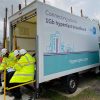BDUK Start Open Market Review for UK Project Gigabit Phase 1

The Government’s Building Digital UK team has today launched an Open Market Review (OMR) for Phase 1b and 1a of their new £5bn Project Gigabit broadband roll-out scheme, which is the process used to identify the commercial coverage plans for 1Gbps networks over the next 3 years (i.e. confirms where public money will be needed).
At present around 40% of homes and businesses across the United Kingdom can already access a Gigabit speed capable broadband ISP network, which is likely to reach over half of premises by the end of 2021 (c.60%) and it’s hoped that commercial deployments could to push this up to around 80% by the end of 2025 (70-80% might be a better expression).
By comparison Project Gigabit, which was unveiled last week (here) and is focused upon the final 20% of predominantly rural premises, wants such speeds to reach at least 85% of UK premises by the end of 2025. The Government also aim to get “as close to 100% as possible” – depending upon how the industry responds (i.e. so far only £1.2bn has been released, but more will be unlocked if the industry shows they can deliver what is needed).
Advertisement
As part of that BDUK plans to run a rolling OMR process, which will work with telecoms operators to establish a maintained national view of commercial build plans for the next three years. By doing this the programme can identify where public funding is most likely to be needed to help extend coverage under Project Gigabit.
The first large-scale OMR Request for Information (RFI) is named for Phase 1b of their rollout plan (here), but confusingly it also seems to incorporate some of Phase 1a.
OMR RFI Geographic Areas:
● East of Cornwall (Lot 33)
● Hampshire and Isle of Wight (Lot 27)
● Norfolk (Lot 7)
● Shropshire including Telford and Wrekin (Lot 25)
● Suffolk (Lot 2)
● West of Cornwall and Isles of Scilly (Lot 32)
● Worcestershire (Lot 24)
Just to recap. More than 1.1 million premises are expected to gain access to gigabit-capable connections in Phase 1a, starting with up to 510,000 premises in Cambridgeshire, Cornwall, Cumbria, Dorset, Durham, Essex, Northumberland, South Tyneside and Tees Valley.
Meanwhile, BDUK expects to announce the next batch of procurements (Phase 1b) to connect up to 640,000 premises in Norfolk, Shropshire, Suffolk, Worcestershire, Hampshire and the Isle of Wight in June 2021. The aforementioned OMR thus seems to straddle a bit of Phase 1a and 1b. Furthermore, there have recently also been separate OMRs launched for Cumbria and Essex (here and here), which adds some confusion.
Advertisement
Otherwise, there’s nothing else particularly new in this document, but at the bottom it does include what appears to be BDUK’s tentative technical definition for gigabit-capable networks (a final one isn’t due to be set until about mid-2021, but for now they’re using this as a guide).
Technical Definition (gigabit-capable)
The UK will review the criteria for gigabit-capable networks within three months of the launch of the Dynamic Purchasing System, based upon the consultation with industry, and the UK regulator, around the criteria below. In the meantime BDUK will work with the following technical definition.
Infrastructure that can support gigabit-capable downstream services directly or via third-party providers without restriction, as set out below:
a) connections that are gigabit-capable (capable of delivering 1000Mbps or more download speeds) at the time of delivery of the connection without the need for future hardware upgrades or modification4 i.e., gigabit-capability to be available from day one and if the consumer takes a slower speed it must be soft upgradeable without undue delay;
b) products with a clear and comprehensible explanation of the minimum (5) and maximum advertised download and upload speeds;
c) products with 100 Mbps download speed as a minimum;
d) upload speeds in line with industry norms for corresponding download speeds (e.g. typically 20 Mbps and above for 100 Mbps download services, and proportional for higher download speed services);
e) low data latency in line with recent industry norms and/or the requirements of real-time services (e.g. 10 ms and below);
f) maintenance of other technical performance indicators (e.g. jitter, packet loss, contention ratio etc.) in line with recent industry norms industry norms and/or the requirements of real-time services (e.g. voice/video calling, telematics, telemedicine etc.);
g) actual data speeds and performance during the busiest hours of the day (not more than 4 out of every 24), that do not degrade more than 50% below the higher of these criteria (6) and providers’ service specifications (note: for performance where lower values are better, such as latency, jitter and packet loss, then a factor of 100% above would apply instead);
h) actual data speeds and performance that do not degrade outside of the busiest hours below 95% of the higher of these criteria and providers’ service specifications;
i) actual data speeds and performance that do not degrade as take-up of services approaches 100% of the addressable market (including any part arising from switch-off of legacy networks), to be demonstrated by firm commercial and technical (including capacity upgrade) plans.
j) where service offerings and performance vary by locality e.g. as a result of subscribers’ distances from infrastructure, gigabit-capability to be maintained for all potential customers;
k) order fulfilment and rectification within typical industry timescales, supported by demonstrably efficient wholesale service management processes;
l) maintenance of customer service levels and network availability in line with industry norms, ideally supported by service level agreements;
m) service provision that does not unfairly discriminate against particular types of services, providers, subscribers or third parties (e.g., via traffic shaping or quality of service measures); and
n) for subsidised networks only; offering of wholesale access products on open and non-discriminatory terms in line with the principle of technological neutrality, to enable the interconnection to the subsidised network of any technology which other communications providers and/or retail providers may reasonably consider appropriate in accordance with the wholesale access requirements.
———–
Footnotes (linked to (5) and (6) above):
5. Minimum download speeds may include the usual framing and packet overheads of the technologies used, provided that they amount to no more than a few percent of the total traffic i.e. data speed is defined as (user data traffic + overheads) / time
6. Typically contention ratios of around 20:1 to 30:1 have been found to meet these criteria and should not be exceeded unless it can be otherwise demonstrated how these criteria would be met. For the avoidance of doubt, the performance criteria take precedence over contention ratio considerations.
The above seems fair enough, considering that the government are focused on building consumer broadband services and not expensive private uncontended leased lines to homes (residential connections share their capacity in order to remain affordable for consumers and there has to also be some allowance for other variations).
Mark is a professional technology writer, IT consultant and computer engineer from Dorset (England), he also founded ISPreview in 1999 and enjoys analysing the latest telecoms and broadband developments. Find me on X (Twitter), Mastodon, Facebook, BlueSky, Threads.net and Linkedin.
« Netgem TV Expand Service for UK ISPs via SuperStream WiFi Mesh
Poor Broadband Means UK Gov Stuck with BBC TV Licence Fee »























































All I can say is its about time the government grew a pair, and insisted that if operators are providing a gigabit capable FTTP solution, then it should enforce the fact that a symmetrical gigabit service must be provided if full voucher funding is to be made available. If an operator provides less, such as the pawltry 100mbps as indicated in tyour article, then operators should only get a percentage of the voucher amount, in that case 10% since they are only delivering that capacity of the fibre.
It’s worth considering that even GPON FTTP networks can deliver symmetric speeds, but under the hood your upstream would still be constrained at the PON (2.5Gbps down / 1.25Gbps up) and this applies to a lot of full fibre altnets too (i.e. promising something that might become harder to deliver as more people join your network).
So, while I don’t completely disagree with your argument, the reality is that if the government were to take that approach then they’d have to rule out a lot of the current market players – including heavyweights – and that would make Project Gigabit undeliverable in a reasonable time-frame.
But we shouldn’t forget that with FTTP, it’s all about getting that cable in the ground. Once it’s there you can change the kit at either end to upgrade these things with time.
When will we actually find out who the providers of FTTP are in these places and when will be able to see which properties will be covered?
Procurements take a long time, and it’ll thus be the “first half of 2022” before the first contracts are awarded under the new Dynamic Purchasing System (DPS).
@Mark Jackson, does “first half of 2022” include phase 1b or not? I’m a bit confused now as you mention in the article that they’re doing both at the same time.
Too early to tell, but I’d imagine Phase 1 (a/b) areas. Might also cram Phase 2 in as it’s quite a big window of time.
Look like Openreach can’t be bother to roll out FTTP in Shropshire (including Telford & Wrekin) shame on you BT
With OR now committing to 20m there is a high likely hood OR will rollout, just not yet. OR has pockets of FTTP in the area (mainly New Build) but FoD is available.
Most of Telford is covered by VM with high market share.
You have Altnets already present such as Exascale specially to the north of Telford.
Non commercial will be part of the Out/In procurement.
Doesn’t sound too bad
Meadmodj
Virgin Media are awful service and high cost! We all rather to have openreach FTTP. As for Exascale they are very limit in Telford only around businesses area in Hortonwood.
“FoD is available”
This is a common myth still believed by many. FTTPoD for all intense and purposes is a dead product. Only a very limited total number of FTTPoD orders are accepted per year, and order fulfillment often take more than a year. And it is a hopelessly overprice product, in most cases there are better alternatives.
The basic idea of extending fibre from cabinets to the premises was good, and this feature was even promised by some early BDUK projects (Wales?), but it never took off.
ASDL Max openreach is a commercial operator and makes a commercial decision to spends its money where it makes a return on its commercial investment
if you want it tyhat bad you could do a CFP in your community
surprise surprise Telford and Wrekin is not the centr of the universe
Is BT expected to identify the 3.2m rural premises by 2025 (or 7m by 2031) now incentivised by Ofcom so these are deducted from what are mostly premises with FTTC available? Apart from the cabinet all other elements of the subsidised FTTC upgrades are ‘gigabit’ capable.
It will be interesting to see how this pans out as the incremental demand for >30-80Mbs is not proven and neither is the incremental CVA to justify a subsidy. There is no indication in this or the earlier Cumbrian or Essex consultations that those so far excluded from any upgrade will be prioritised?
They have said that priority will be given to sub-30Mbps areas, albeit not to the exclusion of all else.
No prioritisation exists in the consultation papers so far. Unless those postcodes are identified there is no prioritisation and the initial funding actually allocated will only cover a fraction of what is being proposed.
This will inevitably be driven by the Government’s objective of meeting their 85% target of “Gigabit capable” premises by March 2026. Although they still need to address USO and the current BDUK projects I suspect they will be looking for the maximum number covered in the procurements as they know the net increases in commercial areas will be subject to significant overbuild both FTTP/FTTP and FTTP/HFC, especially the latter.
@meadmoj – BDUK in the last reported six months of superfast delivered 9k rural premises a month of ‘gigabit-capable’ with 438k premises or 3.7 years worth of work under contract yet to be delivered.
The BT/Ofcom 3.2m rural premise upgrades equates to ~50k a month rural premises until 2025-26 with more to come to 2031 7m forecast.
There may not be a problem to solve apart from the extremities of the English counties.
BT could quite reasonably state that under the 3.2m agreement that half of the 20% (6m) will be done but we cannot tell you which half and all can be done by 2031 but the bits BDUK are struggling to currently struggling to finish.
This will drag on as Government do not have access to £5bn but £1.2bn which is less than the 2012 budget.
Overbuilding what has already been subsidised in problematic. If BT lose they will point to the 3.2m agreement being undermined. If alt-nets lose they will point to the ££millions raised to challenge BT who already has an agreement with Ofcom.
Hi all,
Can anyone tell me if this scheme would benefit our neighbourhood? We all have EOL lines, we’re surrounded by FTTC, but we aren’t on the BTOR future plans site. We do have access to VM, so would this mean we’re not eligible? We’re covered by the after phase 2 works I think.
Finally it appears the Government is starting its Election Promise of “100% Gigabit Broadband Coverage”
>the target is lowered to 95%
Every time….